During 2008 Nigel held the ABC Radiophonic Fellowship and developed a project entitled GhosTrain that deals with memories (and amnesia) surrounding Sydney’s Eveleigh Railyards.
The first stage of the GhosTrain project created a series of short Radio Broadcasts and a Podcast website focused on the Redfern Locomotive & Eveliegh Carriage Works. The project addressed the oral histories and acoustic ecologies of Industrial culture. The second stage developed this content into a major sound-installation for TPS at The Carriage-works and the proposed third stage will see an Oral History project for mobile devices.
The overall work aims to create a series of ‘audio-portraits’ of the Redfern Locomotive & Eveliegh Carriage Works that encompass, the oral histories and acoustic ecologies of Industrial culture. Audio content will be drawn from an Oral History project to be established with former Railroad workers, archival sources, actuality recordings of Rail technology and environments as well as from a series of contemporary rail journeys.
Here are the five radiophonic works.
GhosTrain_01
GhosTrain_02
GhosTrain_03
GhosTrain_04
GhosTrain_05
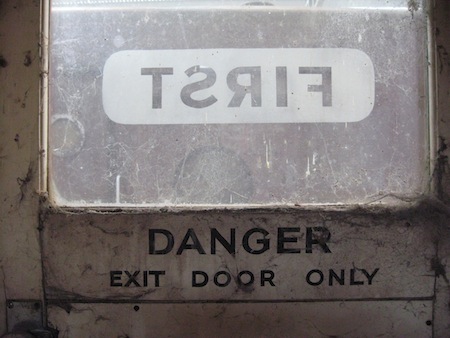
When we consider changing socio-economic landscapes we naturally focus our attention upon the more obvious physical features of the shifting usage of architectural structures and major environmental infrastructures.
In a marked contrast, the transient elements, that are the soul of living cultures, are difficult to seize upon and tend to be quickly forgotten; erased under changing patterns of work and social usage. The iconic sounds that characterise a locale are one of the most fragile and difficult of these transient elements to recognise, evaluate and value.
The acoustic ecologies of industrial landscapes are prime examples of our extraordinary capacity for amnesia. Closely observed every location has a characteristic ‘soundscape’ in effect a sonic ‘fingerprint’, formed from a complex mix of smaller incidental sounds’ punctuated by unique, ‘keynote’ sounds that are site-specific and directly associated with the particular structures and activities found at the location. Good examples of the iconic nature of “Keynote” sounds are the Imman’s call to prayer in Istanbul or the Fog-horns of San Francisco.
The discipline of Acoustic Ecology recognises that contemporary trends driven by Globalisation, the ubiquitous spread of urbanism, mechanised transport and forms of labour result in a homogenisation of world ‘soundscapes’, reducing both the variety, character and uniqueness of local acoustic ecologies.
This proposal seeks to redress such oversight by addressing the unique Architectural heritage and social history of the Redfern Locomotive & Eveliegh Carriage Works sites from a sonic perspective ~ recognising the importance of the soundscape that once characterised the site and endeavouring to re-instate specific elements of its acoustic ecology and oral history.
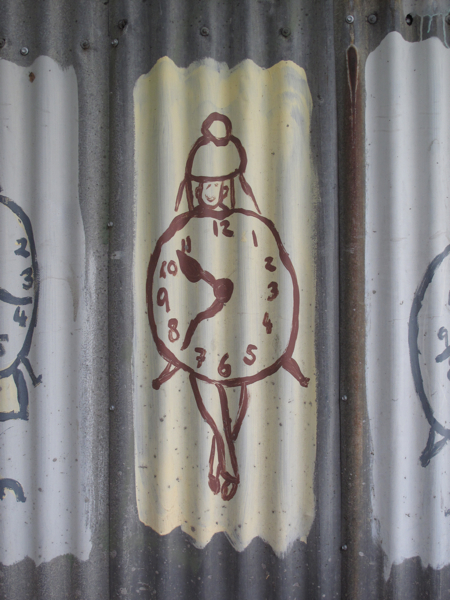
GhosTrain ~ History and Amnesia
I’m very, very concerned about this construction of history as somehow
divided from the present, there is a continuity there always will be. It
suits certain interests to construct the past as a foreign country which can then be commodified for exploitation, be it cultural, tourism of some sort, or redevelopment of sites to make them appear unique, however, I dispute this ‘discontinuity’ view of the past.
Lucy Taksa.
The Eveleigh Railway Workshops site is impressive on many levels; its robust industrial architecture, the simple repurposing of the site as a cultural space; set against the lingering knowledge that this was a site of labour ~ of specialised knowledge and skill and of a lifestyle all but forgotten in Sydney’s upwardly mobile affluent society.
In considering the changing socioeconomic landscape of our cities our attention is drawn towards the more obvious physical features of the shifting usage of architectural structures and major environmental infrastructures. However, in marked contrast, it is the transient elements that are the soul of living cultures but these are difficult to seize upon and tend to be quickly forgotten; erased under changing patterns of work and social usage. The iconic sounds that characterise a locale are one of the most fragile and difficult of these transient elements to recognise, evaluate and maintain, yet in essence, they hold the key to memory and identity.
As Lucy Taksa indicates, the construction of history is a premeditated political enterprise and creates a sharp divide between the unheeded plural voices of individuals and the authorised grand narrative that is History. GhosTrain is not so much about our experience of listening per se but about listening to the stories of a community that has been ignored; a listening in to the silences of a location, not simply to a workplace but to an entire culture that has been conveniently dismissed and transformed in a manner that erases all traces and renders it palatable and commodifiable.
Project development.
GhosTrain is designed in three stages and aims to recognise the importance of the soundscape that once characterised the site and endeavours to reinstate specific elements of its acoustic ecology and the memories contained within oral history. Stage 1 constituted a series of five broadcasts produced at ABC Radio National and established contact with a range of ex-railway workers interlacing their oral histories with commentaries from historians, architects etc ~ in effect the research phase, collecting material and getting under the complex skin of the site.
Stage 2, produced in collaboration with The Performance Space, seeks to reinstate a keynote sound within the main architectural space, to resound the acoustic ecology of the site. Each day the speaker rig will play the 1 o’clock work siren (reputedly once used by all the local shops to set their clocks) to be followed by 90 seconds of a steam loco, shunting along the axis of the building ~ a simple sonic haunting, designed to rekindle people’s memory and associations and to honour those who spent their working lives in the Railyards.
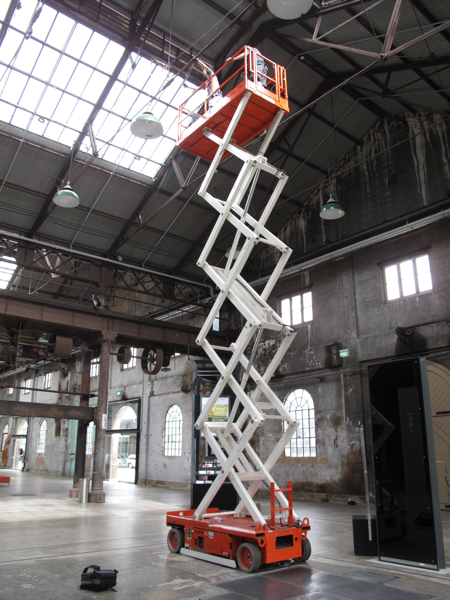
Installing the speaker array along the principal axis of the CarriageWorks.
The final, Stage 3 is in the form of mobile acoustic Ars Memoria. My research showed that many previous employees felt cheated of their working history, seeing the physical locus of their labours gentrified and none of the original meaning or heritage retained or represented (save for some well-hidden brass plaques on the Redfern site). The mere restoration of bricks and mortar is senseless in this context, what is missing is an acknowledgement of the social and cultural histories told in multiple voices from the community and situated in the appropriate places.
I intend to develop a location-sensitive augmented audio-reality reality sonic-cartography which will operate on iPhones with content delivered as a free download via the AudioNomad spot on the iTunes store (this bundles the content and player application). This mobile onsite experience will be augmented by an off-site webbased interactive mapping system entitled “JourneyScapes”.
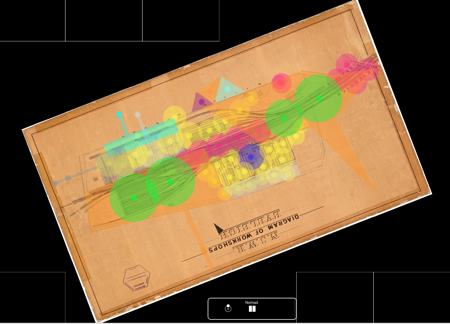
An interactive sound map based upon the original; workshop blueprint.
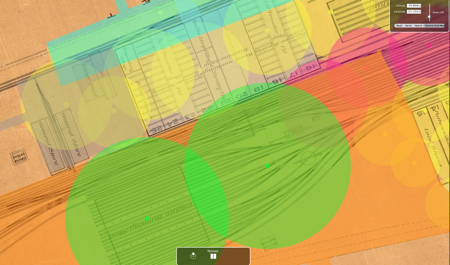
A detail of the interface.
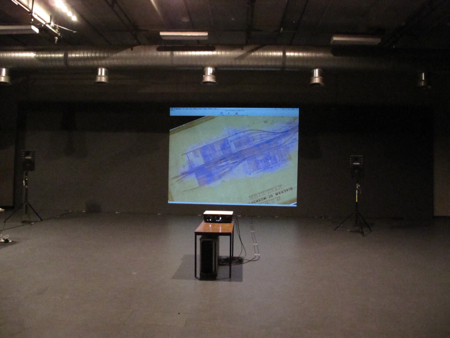
Set up for community discussions of future creative developments.
GhosTrain, a train of thought.
By Robyn Ravlich.
Nigel Helyer is a gifted contemporary artist who uses current audio and computer technologies to make the sounds of the past reverberate to bring the focus of our attention back to what that past entailed. In the second phase of his Ghostrain project, a sonic shade or ghost train is returned to the Everleigh Railway sheds which once sounded with the activity of locomotive cars shunting, blacksmiths forging steel, and railway workers, many of them migrants, conducting carriage repairs amidst lively workforce politics, where one of the rallying spots earned the moniker Red Square.
Acoustic ecology is a discipline which emerged in Vancouver, Canada, in the early 1970s. Its initial aim was to record existing soundscapes with a view to monitoring and possibly resisting the rise of sonic pollution as nature areas were encroached upon by urbanization, and cities in the thrall of globalisation began to sound alike with a thrum of undifferentiated white noise caused largely by cars and air-conditioning. In documenting the Vancouver soundscape, composers R.Murray Schafer and Hildegard Westercamp and their collaborators, identified some sounds unique to that city that were highly evocative of place, such as a foghorn at the entrance to the harbour, and an air horn that played O Canada several times a day in a public park. They called them soundmarks, just as distinctive in the local soundscape as landmarks are in a landscape. Such sounds are not only place markers but sometimes they become memorial markers of what has been lost from the soundscape and so from our worlds.
Composers and sound artists remain at the forefront of the acoustic ecology movement, along with acousticians and environmentalists, so it’s not surprising that a creative leap has occurred and that soundscape art and compositions are being made alongside scientific and historical recordings. Sound installations and composed soundscapes are floated in the air via radio broadcasts and in site-specific spaces so that we might hear a series of sound portraits of cities like Lisbon, Buenos Aires, or Venice, or the laments of Irish dormitory girls consigned to laundry work. Sound is evanescent, and ephemeral, but once captured in a recording it can have a powerful and poignant effect when replayed. We can become aware of the sonic traces of something that is changing or that has been and is no more. Sound is highly evocative and stirs the imagination. It can make us feel, reflect, think.
Nigel Helyer’s Australia Council-ABC Radio National residency project in 2008 was the first phase of Ghostrain, a collection of concise compelling portraits and oral histories of the Everleigh Carriageworks imagined as audio railway stations. It was broadcast as short audio features on Radio National’s Hindsight program in 2009, and disseminated also via podcast and on the social media site Pool (pool.org.au). The five sound-rich episodes of Ghostrain used the oral histories recorded by Nigel Helyer with former Everleigh workers to paint a fascinating picture of a highly masculine work environment replete with ethnic tensions eased by pleasurable interactions around continental food. Architects and historians also spoke in the programs about the impressive industrial architecture and its creative adaptation to new uses. Nigel Helyer’s Ghostrain installation of a keynote sound of a steam train is contemporary art in its own right as well as a timely historical reminder. It acknowledges the past use of Carriageworks, and also signals the reinvention of the majestic industrial space as an art and performance space giving new life to an emerging cultural precinct in the Chippendale-Darlington locale.
This dynamic use of sound was also evident in the work of another ABC artist in residence, Robert Iolini, whose 2002 ABC work, The Sounds of Forgetting, incorporated ABC archival recordings into a radiophonic soundscape of Sydney lost to development. The title suggests a disturbing process of urban amnesia: when activities and places disappear, sounds disappear, and we can too easily forget.
Ghost trains suggest something that was that is no more. They suggest a morbid funfair ride on a train travelling through the dark out of which skeletons appear. But ghost trains are rarely seen, they are heard. It is the iconic sound of a train whistle coming around a bend or a steam engine starting out from a station and chuffing up to departure speed that most engages the imagination as with Nigel Helyer’s Ghostrain sounding through the air of Carriageworks.
Everybody has their train of thought. Mine is a childhood journey on the Silver City Comet from Broken Hill to Sydney, a journey that lasted a tedious day measured by the even rhythm of wheels clacking along the tracks and an evocative night ascent to Lithgow where a steam engine hauled us over the mountains with the majestic whistle blowing as we rounded the bends on our journey down to the coast. At Central’s terminus we were met by my grandmother and her railway worker friend Frankie in his spiffy dark cap and uniform. My grandmother, a tiny slip of a woman, was an industrial machinist and sewed upholstery for the Southern Aurora and other trains, out at Clyde. She lived at Lidcombe across from the railway station, and the sound of country and suburban trains stopping, starting and in transit lent a romance to our holiday nights. Those trains seemed magical to me, linking country to city with diverse freights of goods and people, and all the suburban parts of the city drawn to its heart. That main western line took us past a suburban and industrial landscape of flour silos and the massive Everleigh railways sheds and yards before the final run into the mysterious tunnels that led under the city centre.
Writing this makes me realise how much is gone, how much industrial activity has disappeared from Sydney, how many workers have disappeared from sight and sound, and how work and modes of transport have changed.
Robyn Ravlich, Executive Producer Music Unit, ABC Radio National, January 2010.
And if you still have energy here is the: –
GhosTrain ~ The Original Project Descriptor:
The Eveleigh site is impressive on many levels; its robust industrial architecture, the simple but effective re-purposing of the site as a cultural space; set against the lingering knowledge that this was a site of labour ~ of specialised knowledge and skill and of a lifestyle all but forgotten in Sydney’s upwardly mobile affluent society (well that’s a nice way of putting it!).
• The GhosTrain project will be developed in two phases with three principal outcomes, Radio Broadcasts, a Web presence and an Architectonic sound installation.
The first part of the ABC work will comprise of a period of research, to generate an extensive sound-library. This library will consist of material drawn from; local archival sources, the establishment of an oral history project with former workers and labour organisations at the Rail Yards, and archival and direct recordings of Railway technologies (e.g. field recordings of trains and train operations). Additional content will be recorded on a series of contemporary railway journeys in Australia and the Asia Pacific area.
GhosTrain will develop an extensive Social Network primarily through the content generation phase of Archival Research and especially the Oral History project. I envisage maintaining and developing local groups and encouraging them to become involved with the subsequent web and installation aspects of the project.
Audioworks for Radio Broadcast:
The second part of the ABC project will be the composition and realisation of a series of short Radio broadcasts that deliver Audio-Portraits of the Redfern Locomotive & Eveliegh Carriage Works, its working histories and the technologies and experiences of Rail travel. These short compositions will be designed to function as a series of broadcast ‘shorts’ and to be suitable as stand-alone PodCasts for a specially created GhosTrain website (also available to the ABC website).
This proposal seeks to develop this matrix of linkages into a web-based platform that will further extend the potential for both research and growing social networks ~ in effect exposing a sector of the working public (ex Rail yard workers) to a creative, cultural process that would otherwise remain distant.
Soundsculpture Installation:
The ABC project will furnish material for a subsequent development proposed to The Performance Space and The Carriage Works as an interactive sound-sculpture installation, distributed throughout the Carriage Works allowing visitors to take a mobile unit and activate ‘sonic memories’. This will be augmented by a single daily keynote sound event (say at noon) in which a leitmotiv sound will pass momentarily along the axis of the foyer space ~ for example; a recording of a steam locomotive moving past a platform, a sort of sonic haunting lasting some 60 seconds only ~ a ghostly time marker!
The physical installation will comprise up to 24 small Rail structures (sculptures) installed throughout the Carriage Works. These ‘stations’ will be modelled upon fragments of viaducts, bridges, rail heads etc ~ the salient point being that they will all include a short section of ‘track’. I imagine each of these structures to be no more than 1.5m high, 1.5 wide and about 0.5m deep, they will be attached to walls or columns and made of Steel, Wood and Aluminium.
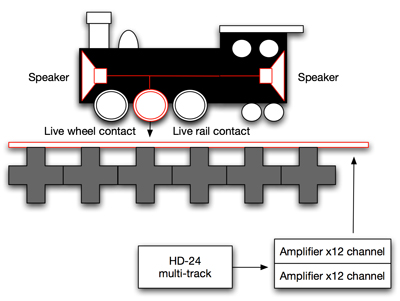
This ensemble of ‘stations’ will be fed by a live audio stream (from a x24 track hard drive and x24 channels of amplification). However, instead of running to speakers, the signal will terminate (silently) on the sections of the track.
Visitors will be invited to take a small and slightly abstracted locomotive (these will be some 400mm in length rather like a ‘Lionel’ model train). When placed upon any section of track the audio narrative will emanate from the speaker encased in the Locomotive’s body, thus visitors will actually ‘perform’ a journey to audit the work.
If no Locos were in situ, then no sound would be heard in the building, alternatively if several were placed here and there, then an atmosphere of narratives and rail-related soundscapes will inhabit the space.